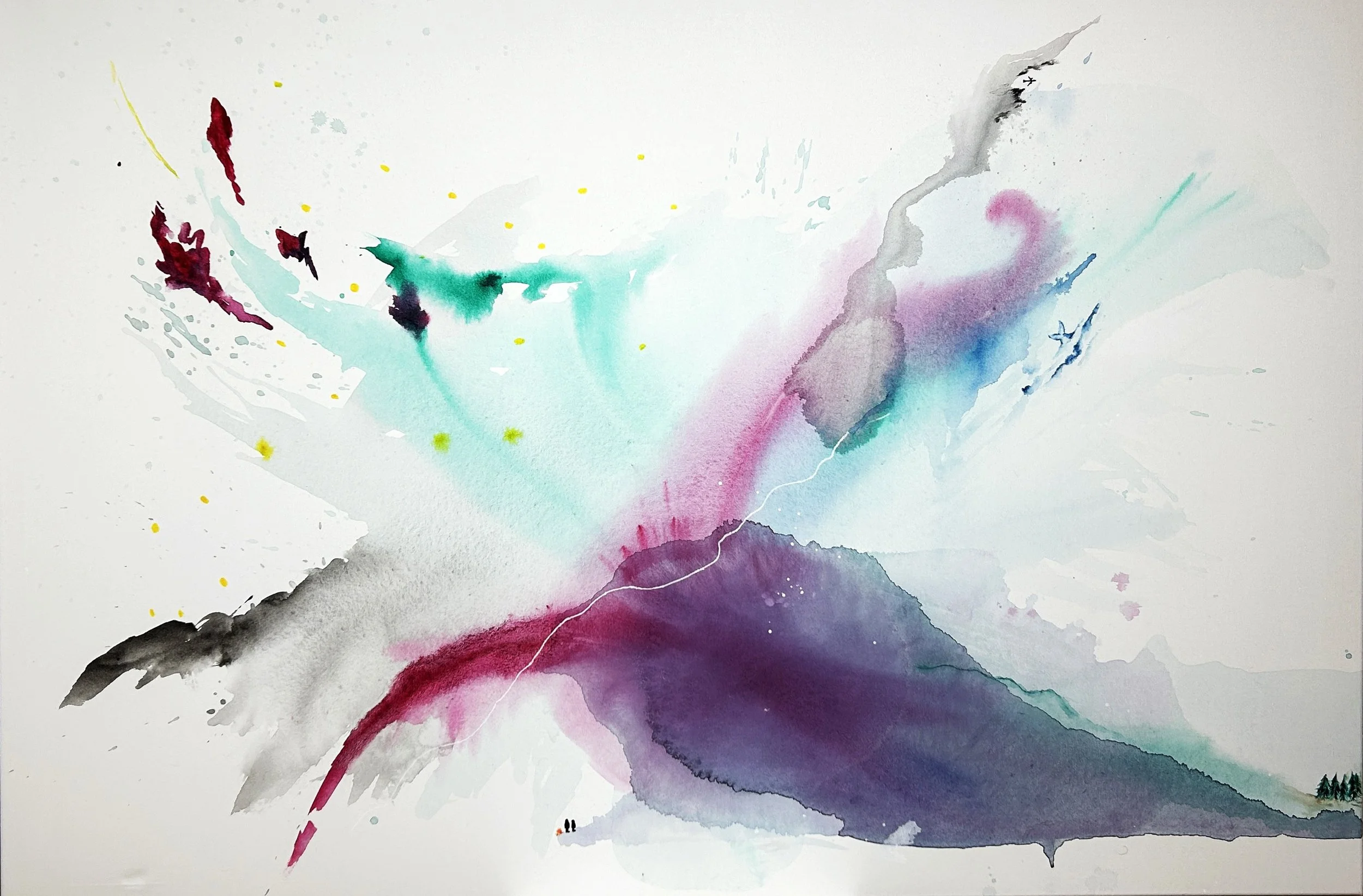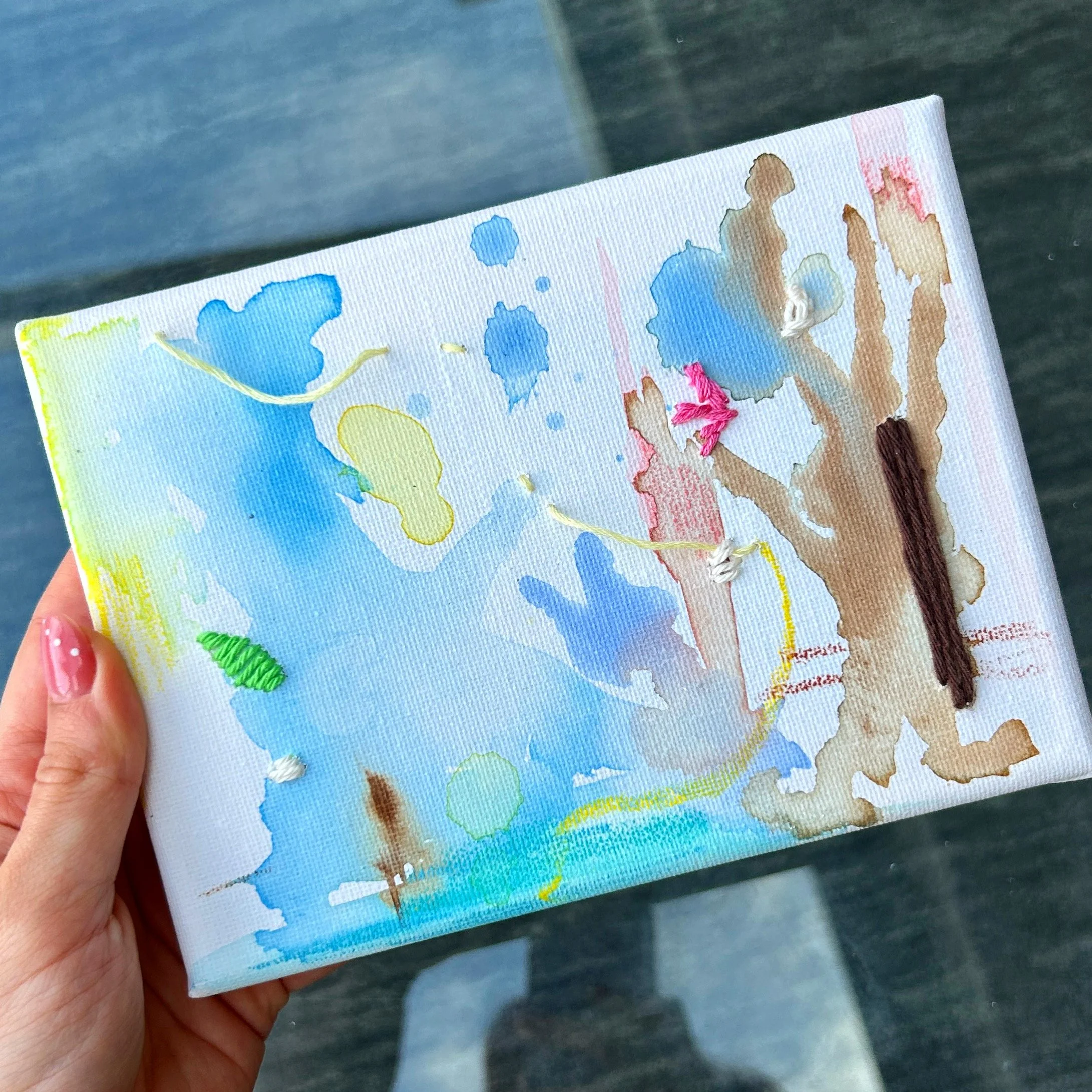Artist in conversation: Merve N. Kocak
“ Creating serves as a form of meditation for me; it's my sanctuary for relaxation and mental clarity. ”
Merve is an illustrator based in The Netherlands. She works with many mediums, such as augmented reality, installations, oil paint, acrylic paint, and ceramics, and combines analog and digital mediums. Merve often gets her inspiration from nature and always tries to incorporate it into her artworks. If she is not in her studio working away, she is on the move, exploring the world.
What initially inspired you to become an artist, and how did you develop your unique style?
I express myself best through colors and textures, turning my feelings into art. Whenever emotions stir within me, I feel the need to capture them visually, not with words but with paint on canvas. This way, I can document what I feel in a more natural and vivid manner, using watercolors and paints to share my inner world. Through my art, I can hold onto moments and express them in a way that feels right to me. Moreover, I occasionally incorporate a digital layer of augmented reality (AR) into my paintings, embedding hidden elements within the artwork. This could be a sketch of a cherished memory that materializes when you scan the painting or perhaps a song that plays. This fusion of traditional art with digital technology invites viewers to uncover these concealed treasures, adding a layer of interactivity and personal discovery to the experience.
In terms of subject matter, what themes or motifs do you frequently explore in your work, and what draws you to these topics?
My artistic process is incredibly reflective, constantly pulling from my reservoir of feelings and experiences. Every location that evokes a recollection or a familiar feeling calls out to me to express its spirit in my own unique way. I chose to paint my experiences and sentiments on canvas instead of in a regular diary, using a variety of colors and forms. Through this procedure, I'm able to capture life's special events on film and share them with the world in a way that goes beyond traditional narrative techniques.
Could you walk us through your typical day in the studio? How do you approach a new project, from ideation to completion?
Whenever an idea for a painting strikes me, I spend days thinking about it, evaluating various concepts to determine the most effective approach. Next, I approach my collection of paints, selecting a color palette that best mirrors my theme. With colors chosen, I then focus on shapes and the overall composition. Once the initial layer is on the canvas, I pause to reflect and plan further steps. After taking a day's break, I resume painting, continuing this cycle as necessary until the piece feels complete. Following this, should I feel compelled, I introduce a digital layer of augmented reality (AR) to infuse the artwork with a hidden layer of meaning. This subtle integration allows me to embed a secret significance within the piece, offering an intimate discovery for those who engage with it more deeply.
Your use of both analog and digital mediums is intriguing. How do you find a balance between the two, and what unique advantages do you see in combining them?
I embrace analog methods as my primary medium to convey my emotions, infusing my work with a touch of digital innovation for an extra spark. Imagine paintings that reveal hidden drawings upon scanning, or ceramics that come to life with a small animation. My approach is deeply experimental, finding each digital medium an exhilarating frontier for conceptual development. As expressed on my portfolio page, my creative impulses are varied and boundless: Today I want to knit, tomorrow I want to program. I combined these two on the third day, and I'm looking forward to the fourth.
Can you share a specific piece or project that holds particular significance to you, and walk us through the creative process behind it?
I'd like to share the story behind "Kerid," an artwork born from my travels to Iceland. Kerid, with its captivating beauty, made a profound impact on me. Standing near this enchanting site, I was struck by a deep sense of familiarity and connection. I was determined to encapsulate this feeling within my canvas. After reflecting on this sensation for several days, I finally set to work. Now, each glance at the painting transports me back to that moment, reminding me of the emotions I experienced and the breathtaking beauty of Kerid.
How do you incorporate feedback from critics and audiences into your artistic practice, and how do you balance this feedback with your own artistic intuition?
I'm open to ideas and constructive criticism, as I believe it's crucial for growth. However, it's equally important for feedback to resonate with my values as an artist. While I remain steadfast in my mode of expression, I'm endlessly open to new sources of inspiration. When I find that the advice aligns with my principles, I'm more than willing to integrate it into process of my work. I recognize that the creative journey is unique for each artist and viewer, highlighting the diversity of our experiences and perspectives. This understanding fosters a mutual respect for our individual stories and processes. By embracing this approach, we can exchange feedback in a manner that is both positive and conducive to artistic development.
How do you stay motivated and inspired despite any setbacks or creative blocks you may encounter?
Creating serves as a form of meditation for me; it's my sanctuary for relaxation and mental clarity. Whenever I face setbacks, retreating to my studio to create brings me peace. Visiting museums, I immerse myself in new art and encounter fresh perspectives, which rejuvenates my spirit. This journey feels endlessly fortunate, with creativity's boundless nature constantly inspiring me. Whenever doubt creeps in, the work of other artists lights my path, encouraging me to explore new avenues. Each time, I emerge refreshed, ready to embrace the infinite possibilities of creation.
How do you feel about exhibiting your artworks with The Holy Art Gallery?
I'm really excited about this opportunity. Although I've never been to New York, my work is now there, thanks to The Holy Art Gallery.
Looking ahead, what are your long-term goals and aspirations as an artist, and how do you plan to achieve them?
Looking ahead, my long-term goals as an artist are deeply rooted in the inspiration. I aspire to become a source of inspiration myself, creating art that resonates and motivates. My ambition is to travel extensively, immersing myself in the global creative community, experiencing the diversity of artistic expression firsthand, and sharing my own creative process. To achieve these goals, I plan to engage in collaborative projects, participate in international art residencies, and showcase my work in various cultural contexts. Through these experiences, I aim to enrich my artistry and contribute to a vibrant exchange of ideas within the artistic community.
What role does emotion play in your creative process, and and how do you aim to evoke specific feelings or reactions from those who view your artworks?
Emotion is the cornerstone of my creative process, serving both as my muse and my medium. It guides the inception of each piece, influencing the choice of colors, textures, and compositions. My aim is to craft a visceral experience for viewers, one that transcends visual aesthetics to touch upon the shared human experience. By embedding my own emotional landscape into my art, I strive to evoke a spectrum of feelings and reactions in those who engage with my work. Whether it’s a sense of serenity, a rush of nostalgia, or a spark of joy, my goal is to create a resonant emotional connection. To achieve this, I delve deeply into the nuances of emotion with each stroke, layer, and hue, inviting viewers into a dialogue that is both intimate and universal.






